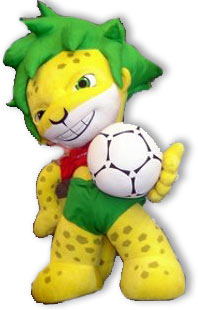The first World Cup mascot was Willie the Lion from the 1966 tournament, and was one of the first mascots to be associated with a major sporting competition (the first Olympic Games mascot was in 1972).
The mascots are mostly marketed to young children. Traditionally, mascot designs often represent a characteristic feature or animal of the host country. In terms of animals, so far we have had two lions, a leopard, rooster, and a dog. There has been an orange and a chilli pepper, and a few little boys.
| year | mascot | description |
|---|---|---|
| Qatar 2022 | La'eeb | described as "indescribable", hailing from the mascot-verse, though it does look a little like the traditional cloth headdress worn by men in Qatar. La'eeb is an Arabic word meaning super-skilled player |
| Russia 2018 | Zabivaka | The official mascot of the 2018 World Cup in Russia is a wolf called Zabivaka, which means "the one who scores" in Russian. The mascot wears red shorts and a blue and white T-shirt, the same colors as the Russian National team. The mascot was chosen after more than one million Russians voted on a poll on FIFA.com. |
| Brazil 2014 | Fuleco | Fuleco is a cartoon armadillo, modelled on the three-banded armadillo, an endangered species which is indigenous to Brazil and known as the "tatu-bola". The name is derived from a combination of the Portuguese words for football (futebol) and ecology (ecologia) |
| South Africa 2010 | Zakumi |  Zakumi is a leopard, a common animal found in South Africa. Called Zakumi, he is a friendly green haired yellow leopard, wearing a shirt saying South Africa 2010. Zakumi's green and gold colors represent South Africa's national sports' teams colors. The name Zakumi is derived from "ZA" an acronym for south Africa and "Kumi" which translates as "10" from some African languages. Zakumi is a leopard, a common animal found in South Africa. Called Zakumi, he is a friendly green haired yellow leopard, wearing a shirt saying South Africa 2010. Zakumi's green and gold colors represent South Africa's national sports' teams colors. The name Zakumi is derived from "ZA" an acronym for south Africa and "Kumi" which translates as "10" from some African languages. |
| Germany 2006 | Goleo VI and his sidekick Pille | 2006 saw the return of the lion, this time wearing a Germany shirt with the number 06 and no pants! He also had a talking football named Pille. Goleo is a portmanteau of the words "goal" and "leo", the Latin word for lion, while "Pille" is a colloquial term for a football in Germany. |
| Korea/Japan 2002 | Ato, Kaz and Nik (The Spheriks) | This was the first tournament to have more than one mascot, in fact they had three. Ato, Kaz and Nik were orange, purple and blue futuristic, computer-generated creatures. They also had their own sport - "Atmoball" (a fictional football-like sport). The three names were voted for online and at McDonald's outlets in the host countries. |
| France 1998 | Footix | The 1998 mascot was a rooster, one of the national symbols of France. It has the words "FRANCE 98" on its chest, with its body mostly blue, like the host's national team shirt. The name Footix is a portmanteau of "football" and the ending "-ix" from the popular Astérix comic strip. |
| USA 1994 | Striker, the World Cup Pup |
The mascot chosen by the US public for USA '94 was a dog, which is a common US pet animal. Striker wore the red, white and blue US colors with the words "USA 94". |
| Italy 1990 | Ciao | This was a different looking mascot, a stick figure player with a football head and an Italian tricolor body. The red white & green blocks of the body made it look like it was made from lego. Its name is an Italian greeting. |
| Mexico 1986 | Pique | Following the fruit and vegetable theme from the previous tournament, the mascot of Mexico 1986 was a jalapeño chili pepper, which we all know is a characteristic of Mexican cuisine. The chili also had moustache and was wearing a sombrero. Its name comes from picante, Spanish for spicy peppers and sauces. |
| Spain 1982 | Naranjito | The 1982 mascot was a small orange, a typical fruit in Spain, with a big grin. He was wearing the kit of the host's national team. Its name comes from naranja, the Spanish word for orange, with the diminutive suffix "-ito". |
| Argentina 1978 | Gauchito | A boy wearing Argentina's playing pale blue and white playing kit. His hat, neckerchief and whip are typical of gauchos. The hat had the words ARGENTINA '78. |
| West Germany 1974 | Tip and Tap | Two boys wearing the white shirts of Germany, one shirt with with the letters WM (Weltmeisterschaft, German for World Cup) and the other with the number 74 on the front. |
| Mexico 1970 | Juanito | A boy wearing Mexico's colors and a Mexican sombrero (with the words "MEXICO 70"). His name is the diminutive of "Juan", a common name in Spanish. |
| England 1966 | World Cup Willie | The first World Cup mascot was Willie the lion, which was hugely successful and was pioneering in the use of mascots for major world sporting events. The lion is a typical symbol of the UK (although the tournament took place only in England), and Willie wears a Union Flag jersey with the words "WORLD CUP". |
Related Pages
- Other sporting Mascots: Olympic Games, Winter Olympics, Commonwealth Games
- Copa América Mascots
- Major Sporting Event Mascots
- World Cup Traditions
- More World Cup History


 Current Events
Current Events